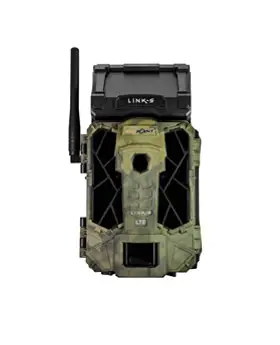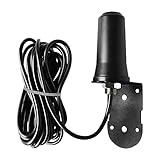If you are an avid hunter or simply an avid trail camera user, you may have noticed a few trends in the world of trail cameras. One of these trends is the use of cellular technology and another is the use of external power supplies, specifically solar panels.
Cellular trail cameras allow you to see the pictures the trail camera has captured on the same day they are taken without having to invest the time and money to travel to where the trail camera is posted. Plus, not having to go physically retrieve the memory card in order to see the pictures the camera has captured not only helps to keep the camera’s location hidden but also helps eliminate the chance of spooking deer or any other game animals that might be in the area.
Then with the addition of solar panels, cellular trail cameras, which typically consume more battery life than their non-cellular counterparts, can be left unattended for as long as necessary without fear of having dead batteries.
Both the SPYPOINT LINK-S and the SPYPOINT LINK-S-V not only follow the trend of incorporating cellular connectivity into trail cameras but also have a solar panel that is seamlessly incorporated into their design.
Table of Contents
Introducing the SPYPOINT LINK-S & SPYPOINT LINK-S-V Trail Cameras

The popular SPYPOINT LINK-S and LINK-S-V share all of the same specs and features with the only difference between these two cameras being the cellular network they use with the SPYPOINT LINK-S using AT&T’s cellular network and the SPYPOINT LINK-S-V using Verizon’s cellular network.
Part of what makes these cameras stand out is their pairing of cellular connectivity and a solar panel, combined with a bunch of great features and high-end specs.
So let’s keep going with our review and find out more about what makes these cameras great and what they might be able to improve upon.
Pros
- Integrated solar panel
- Amazingly fast trigger speed
- Long detection range
- Long flash range
- Easy to use
- Affordable data plans
- Multiple recording modes
- Geotagging – allows the camera to send GPS coordinates while it communicates accordingly with the chosen settings and plan.
Cons
- Low glow flash
- Doesn’t send video (most cellular trail cams don’t send video)
- Camera resolution12-megapixels is lower, especially compared to non-cellular trail cameras
- Doesn’t have a password protection feature
Review of Key Features and Benefits of the SPYPOINT LINK-S & SPYPOINT LINK-S-V Trail Cameras
Camera
The cameras have a resolution of 12-megapixels for photos. These LINK-S cameras can record a video at a resolution of up to 720p HD.
In an era where we are used to 1080p video and are starting to see cameras with 4K video recording capabilities, 720p might seem like a low resolution. However, to keep things in perspective you should remember that many cellular trail cameras don’t record video at all.
The cameras also have the Photo First mode, where they take a picture then record a video. It is an excellent feature that will help diversify what your camera captures.
Please note: You can only receive photos over the cellular network. For videos, you have to physically retrieve them from the camera’s memory card. This is due to the high cost of sending videos over cellular networks.
Smartphone App
To access the SPYPOINT LINK cameras remotely you will need to download the free SPYPOINT app. With the application, you can view and sort through your photos as well as adjust the camera’s settings. The app is compatible with both iOS and Android devices.
Some of the features you get on the app include cloud storage, live customer support, GPS Geotagging, and SPYPOINT’s Buck Tracker image recognition software.
Data Plan
Among the most appealing things about SPYPOINT cellular trail cameras, are their affordable data plans. There are four plans to pick from; free, basic, standard, and premium. The free plan, as the name suggests, is completely free and allows you to transmit up to 100 free images each month.
The basic plan requires a $5 per month subscription fee. You can transmit 250 photos per month under the basic plan. The subscription for the standard plan allows you to transmit up to 1,000 photos for $10 per month. Finally, there is the premium package, where you pay $15 each month for unlimited photos.
The cost is cheaper if you opt for an annual subscription, as opposed to going month to month, with discounts of up to 33% off. The SPYPOINT LINK-S uses the AT&T network while the SPYPOINT LINK-S-V uses Verizon.
Motion Sensor
The LINK-S and LINK-S-V have one motion sensor with a 40-degree detection angle. The standout thing about this motion sensor is its 100-foot detection range. It is an impressive length, better than most trail cameras in their class. Depending on where you install the camera some users report that the detection range may be a bit longer than what is listed.
The PIR sensor is adjustable and has three sensitivity settings; high, medium, and low. You pick the most functional one, depending on your surroundings.
Trigger Speed
The SPYPOINT LINK-S and LINK-S-V have above-average trigger speeds. Whereas a large percentage of trail cameras these days have a speed of around 0.4 to 0.5 seconds, these two cellular cameras have a trigger speed of 0.07-seconds. It is the fastest in the trail camera market, helping to ensure that nothing passes by the camera’s lens without being captured.
Flash
Both the LINK-S and LINK-S-V trail cameras come with a low glow flash with a 100-foot flash range. The 42 low glow LEDs won’t spook game animals or visibly illuminate the area they are directed at. However, they do make the front of the camera glow when the flash is in use, giving away its location if someone is looking directly at the front of the camera.
You can set the flash to one of three settings. They are optimal, boost and blur reduction.
Dimensions
The dimensions of the SPYPOINT LINK-S and SPYPOINT LINK-S-V cellular trail cameras are 3.8 x 6.9 x 3.9-inches, which is pretty compact given all the features these cameras have. That said, I wouldn’t call the LINK-S or LINK-S-V a mini trail camera. So if you need a super compact mini trail camera that you can easily hide in its surroundings you might want to look at some additional options.
Time-Lapse Feature
The LINK-S and LINK-S-V each have a time-lapse mode, which can be very helpful if you want to monitor the area beyond the range of the motion sensor. You can also turn it on if you are receiving a lot of false triggers and would rather tell the camera to capture photos at set intervals. The intervals range from 3-minutes to 24-hours and only works for images.
Note that the time-lapse mode is only for photos, not videos. In addition, when you enable the time-lapse feature, you automatically disable the MULTISHOT and DELAY modes.
Remember to keep in mind the data plan you are using when using time-lapse mode. Depending on the time interval you select you could quickly use up your monthly allotment of photos that you are allowed to transmit.
Hours of Operation
If you don’t want the camera to be active 24 hours a day you can enable the hours of operation feature to set the camera to run only between certain hours of the day, which you select.
Normally this feature can help conserve battery life on a camera, but since the LINK-S and LINK-S-V have solar panels conserving battery life isn’t such a big issue. However, what the hours of operation feature does help with on these cameras is to conserve space on your memory card as well as limit the number of photos the camera transmits, which could be very helpful if you aren’t subscribed to the premium (unlimited) package.
LCD Screen
The LINK-S and LINK-S-V each have a 2-inch color LCD screen. From this screen, you can view pictures and videos that were captured as well as adjust the camera’s settings. That said, after the initial setup you probably won’t use this screen very often as most things you do will be handled from the free SPYPOINT app on your smartphone.
Memory Card
As with all trail cameras, you will need to have a memory card to store your pictures and videos when using the LINK-S and S-V. These cameras can accommodate SD/SDHC memory cards with a 32GB maximum capacity. SPYPOINT recommends using Class 10 cards. The SanDisk 32GB Ultra SDHC memory card is a great choice.
Should the memory card become full these trail cameras are also equipped with the continuous file recording feature, where they will override old recordings to create room for newer ones.
As we noted earlier, these cameras don’t send videos over the cellular networks. So if you have the camera set to record videos, you will have to physically get them off of the camera’s memory card. So like other trail cameras, it is probably a good idea to have a couple of memory cards to reduce the amount of time spent by the camera in order to minimize any disturbance your presence causes to game animals.
- Fast for better pictures and Full HD video (2); (2) Full HD (1920x1080) video support may vary based upon host device, file attributes, and other factors
- Great choice for compact to mid-range point-and-shoot cameras
- From 32GB to 256GB (1) to store tons of pictures and even more Full HD video (2); (1)1GB=1,000,000,000 bytes Actual user storage less
- Exceptional video recording performance with UHS Speed Class 1 (U1) (5) and Class 10 rating for Full HD video (1080p). (5) UHS Speed Class 1 (U1) designates a performance option to support real time video recording with UHS enabled host devices
- Quick transfer speeds up to 100MB/s. Up to 100MB/s [64GB-256GB; 90MB/s for 32GB] read speed; Write speed, lower Based on internal testing; performance may be lower depending on host device, usage conditions, and other factors 1MB=1,000,000 bytes
Solar Panel
Powering each of these SPYPOINT LINK-S cameras is a solar panel, which is integrated right into their design. These in-built solar panels, which are complemented by onboard rechargeable lithium batteries, ensure that these cameras can run without any power disruptions.
Batteries
The cameras use 8 AA batteries, which are more of a backup because of the solar panel. The SPYPOINT LINK-S cameras are very economical on battery use. Something to note about energy consumption with these cameras is that the exact amount of energy used depends on your selected setting and overall camera activity. If you decide to use batteries, go for Energizer Ultimate Lithium batteries.
- 24 Pack of Energizer Ultimate Lithium AA Batteries
- Leak proof construction protects the devices you love (based on standard use)
- Powers your most critical devices ideal for your smart home devices, outdoor surveillance systems, digital cameras, and handheld games
- Holds power up to 25 years in storage for trustworthy backup energy, so you’re always prepared. Warning: Risk of fire. Battery can explode or leak and cause injury if installed backwards, disassembled, charged, crushed, mixed with used or other battery types, or exposed to fire or high temperature
- Performs in extreme temperatures, from -40F to 140° F, for year round, indoor and outdoor use
Input for External Power Supply
These cameras each come with a 12V DC input for an external power supply.
Image Stamp
The information on the LINK-S and LINK-S-V’s image stamp includes the date, time, temperature, and moon phase.
Signal Strength
You decide between the SPYPOINT LINK-S and LINK-S-V think about which cellular network is most reliable in the area you plan on using the camera in. If you have a poor signal, you can purchase the SPYPOINT CA-01 Long-Range Cellular Antenna Signal Booster with 15-Foot Cable and Mounting Bracket, which is shown below, to improve your reception.
- BOOST SIGNAL STRENGTH: SPYPOINT Antenna Booster CA-01 Long-Range signal booster can help improve signal strength in areas without the ideal cellular signal for your cellular trail cameras.
- OMNIDIRECTIONAL: SPYPOINT Signal Booster Cellular trail camera antenna signal booster is omnidirectional, so there’s no need to mount it to face a particular way to get the best signal possible. As long as you are able to clear as many obstructions as possible it will try to improve your signal.
- EASY INSTALLATION: The Trail camera antenna booster comes with a 15-foot cable and attached mounting bracket for quick and easy installation. For permanent spots, install using the mounting bracket, or simply run the cable up to the highest branch it will reach.
- NO ADDITIONAL BATTERY DRAW: The Trail Camera booster Antenna is passive, so there is no power source needed to improve your cellular signal and it doesn’t draw on the batteries in your Deer Camera. Let it improve your cellular signal without wrecking your battery life.
- WORKS ON MOST CELL CAMERAS FOR HUNTING: The SPYPOINT Booster Antenna CA-01 comes with an adapter that will allow the booster to be used with virtually any cellular camera, not just Spypoint cameras. Improve your signal quality, no matter what camera you are using.
Warranty
SPYPOINT backs their LINK-S cameras with an impressive 2-year warranty, which is longer than most trail cameras manufacturers. The warranty will have your back if the cameras have any problems and will give you peace of mind since cellular trail cameras cost more than entry-level trail cameras.
Included Accessories
Highlighted below are some accessories that come with the SPYPOINT LINK cameras.
- Mounting bracket
- SIM card
- Mounting Strap
- USB-12V cable
- Quick Start Guide
Areas of Use
You can use the LINK-S and S-V in a variety of ways. Besides hunting, they are ideal for nature photography as well as property surveillance and security.
Where these cameras really shine is in their ability to send you images no matter how far you are away. Not only can you stop worrying about dead batteries or the cost of replacement batteries, if you live a distance from where the camera is posted and need same-day information from your trail camera these SPYPOINT cameras can literally save you several hundred or even thousands of dollars in travel expenses over the life of the camera.
Price
A discouraging thing about the SPYPOINT LINK-S and LINK-S-V trail cameras is their higher price. That said, when you look at the solar panel and all the other features you get with these cameras and consider the money they will save you over time in replacement batteries and travel expenses it is pretty easy to justify the price.
Other Options
Do you want to look at what other options are available? If so, you might want to check out our free Find Your Perfect Trail Camera Tool, which shows you trail camera options based on the criteria you select. Otherwise, we have picked out a couple of trail cameras, which are shown below, that we think you might be interested in.
SPYPOINT LINK-DARK Cellular Trail Camera
If you like the LINK-S and LINK-S-V trail cameras, but really need something with no glow flash so you can use it on public hunting land or use for property surveillance and be confident that the camera won’t be seen at night the SPYPOINT LINK-DARK (AT&T) & LINK-DARK-V (Verizon) are great options.
While the LINK-DARK and LINK-DARK-V have a no glow flash the flash range is 80 feet, which is 20 feet less than the LINK-S cameras. Beyond that, the only other difference between these cameras is the fact that the LINK-DARK and LINK-DARK-V cameras don’t have a solar panel that is incorporated into the design. However, if you really want a solar panel to help you extend the amount of time you can leave the camera in the field you can buy a SPYPOINT solar panel and plug it into the external power supply input.
We actually did a full review of the LINK-DARK & LINK-DARK-V cameras that you can read here. Otherwise you can check the price of the SPYPOINT LINK-DARK (AT&T) here or check the current price of the LINK-DARK-V (Verizon) here.
SPYPOINT LINK-MICRO-S-LTE Cellular Trail Camera
If you like the LINK-S and LINK-S-V, but wish they were smaller so they could more easily blend into their environment, or wish the price was a bit lower, the SPYPOINT LINK-MICRO-S-LTE (AT&T) and LINK-MICRO-S-LTE-V (Verizon) are probably just what you are looking for.
In addition to its compact dimensions of 3.1 x 7 x 2.2 inches, the main differences between the SPYPOINT LINK-MICRO-S-LTE cameras and the LINK-S cameras is that the LINK-MICRO-S-LTE cameras come with a shorter 80-foot flash and 80-foot detection range to go along with a 10MP camera (that isn’t set up to take videos). Other than that these are very similar cameras with the same affordable data plans that use the same apps.
If you want to learn more about the LINK-MICRO-S-LTE & LINK-MICRO-S-LTE-V you can read the full review we did on them. Otherwise, you can check the price of the LINK-MICRO-S-LTE (AT&T) here or see the price of the LINK-MICRO-S-LTE-V (Verizon) here.
Final Thoughts
The SPYPOINT LINK-S (AT&T) & LINK-S-V (Verizon) cellular trail camera allows you to monitor an area remotely and does away with always having to have fresh batteries. It has an integrated solar panel, super-fast trigger speed, and long detection and flash ranges! Begin remotely monitoring wild game or your property today!
You can check the current price of the SPYPOINT LINK-S here and see the current price of the SPYPOINT LINK-S-V here.
Last update on 2024-04-20 at 09:02 / Affiliate links / Images from Amazon Product Advertising API








